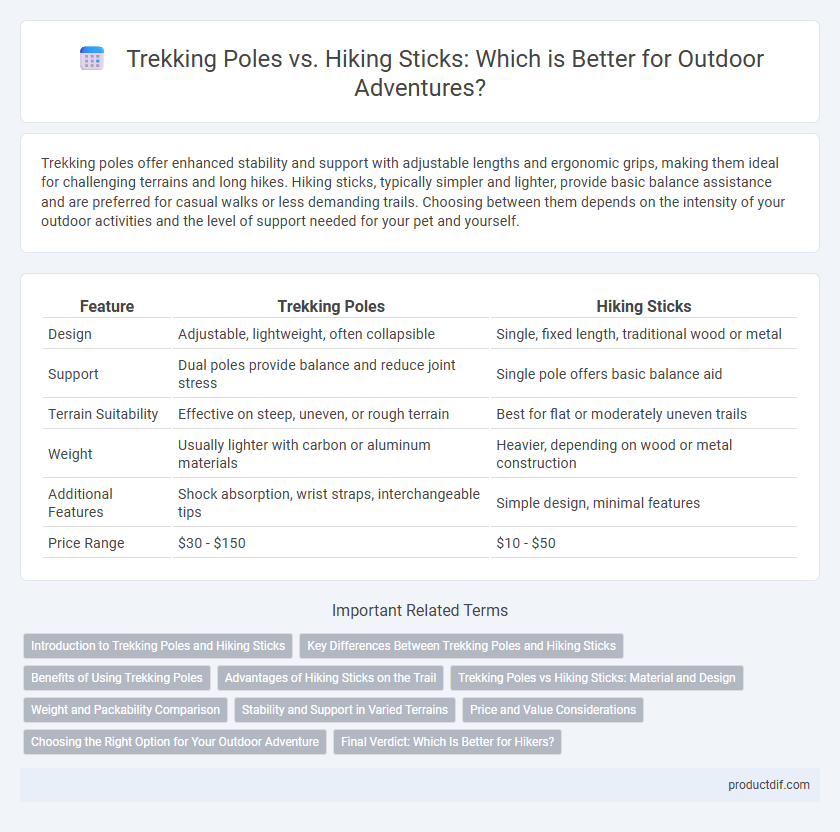Trekking poles offer enhanced stability and support with adjustable lengths and ergonomic grips, making them ideal for challenging terrains and long hikes. Hiking sticks, typically simpler and lighter, provide basic balance assistance and are preferred for casual walks or less demanding trails. Choosing between them depends on the intensity of your outdoor activities and the level of support needed for your pet and yourself.
Table of Comparison
| Feature | Trekking Poles | Hiking Sticks |
|---|---|---|
| Design | Adjustable, lightweight, often collapsible | Single, fixed length, traditional wood or metal |
| Support | Dual poles provide balance and reduce joint stress | Single pole offers basic balance aid |
| Terrain Suitability | Effective on steep, uneven, or rough terrain | Best for flat or moderately uneven trails |
| Weight | Usually lighter with carbon or aluminum materials | Heavier, depending on wood or metal construction |
| Additional Features | Shock absorption, wrist straps, interchangeable tips | Simple design, minimal features |
| Price Range | $30 - $150 | $10 - $50 |
Introduction to Trekking Poles and Hiking Sticks
Trekking poles offer adjustable lengths, ergonomic grips, and shock-absorbing features designed to enhance stability and reduce joint strain on varied terrains. Hiking sticks tend to be simpler, usually made from a single piece of wood or aluminum, providing basic support primarily on moderate trails. Choosing between trekking poles and hiking sticks depends on the intensity of the hike, terrain complexity, and personal preference for added balance and endurance.
Key Differences Between Trekking Poles and Hiking Sticks
Trekking poles typically feature adjustable lengths, ergonomic grips, and shock-absorbing mechanisms, providing enhanced stability and support on various terrains, whereas hiking sticks are usually fixed-length, simpler in design, and lighter to carry. Trekking poles come with interchangeable tips for different surfaces and often include wrist straps to improve grip security, which hiking sticks generally lack. The advanced features of trekking poles make them more suitable for long-distance trekking and challenging trails, while hiking sticks are ideal for casual day hikes and well-maintained paths.
Benefits of Using Trekking Poles
Trekking poles provide enhanced stability and reduce joint strain by distributing weight evenly across arms and legs, making them ideal for uneven terrain and long hikes. They improve balance on slippery or rocky paths, decreasing the risk of falls and injuries. Compared to hiking sticks, trekking poles offer adjustable lengths and shock absorption features, resulting in greater comfort and versatility during outdoor adventures.
Advantages of Hiking Sticks on the Trail
Hiking sticks provide excellent support and balance on uneven terrain, reducing strain on knees and joints during long outdoor excursions. Their lightweight design and compactness make them easy to carry and maneuver, enhancing trail endurance and comfort. Unlike trekking poles, hiking sticks often feature simpler construction, making them more durable and requiring less maintenance in rugged conditions.
Trekking Poles vs Hiking Sticks: Material and Design
Trekking poles typically feature lightweight aluminum or carbon fiber shafts with ergonomic, adjustable grips designed for versatile terrain support, while hiking sticks are often crafted from solid wood or basic metal without adjustment features. The durable materials in trekking poles enhance shock absorption and stability during prolonged use, unlike the simpler design of hiking sticks that offer less customization and reduced impact resistance. Advanced trekking pole designs incorporate shock-absorbing mechanisms and wrist straps for comfort and performance, contrasting with the minimalistic and fixed structure of traditional hiking sticks.
Weight and Packability Comparison
Trekking poles generally weigh between 12 to 24 ounces per pair, offering lightweight support without adding significant bulk. Hiking sticks, often made from solid wood or heavier materials, tend to be heavier and less compact, making them less packable for extended trips. Compact, adjustable trekking poles collapse into smaller sizes, enhancing packability and ease of transport during multi-day outdoor adventures.
Stability and Support in Varied Terrains
Trekking poles provide superior stability and support on varied terrains due to their adjustable length, shock absorption features, and ergonomic grips designed to reduce wrist strain. Hiking sticks typically offer less versatility, often fixed in length and lacking advanced shock absorption, making them less effective on steep or uneven surfaces. The enhanced balance and weight distribution from trekking poles significantly reduce joint impact and fatigue during extended outdoor activities.
Price and Value Considerations
Trekking poles typically cost more than hiking sticks, reflecting their advanced features like adjustable length, shock absorption, and lightweight materials such as carbon fiber or aluminum. While hiking sticks are often simpler and more affordable, ranging from $10 to $30, trekking poles usually fall between $50 and $150, offering enhanced durability and ergonomic benefits. Choosing between the two depends on budget and terrain, with trekking poles providing greater value for extended treks or challenging hikes.
Choosing the Right Option for Your Outdoor Adventure
Trekking poles offer enhanced stability and shock absorption on uneven terrains, making them ideal for rugged trails and long-distance hikes, while hiking sticks provide basic support and are lighter for casual walks. Consider the weight, adjustability, and grip material when choosing between the two to match your adventure's difficulty and duration. Selecting the right pole or stick improves balance, reduces strain on joints, and enhances overall outdoor experience.
Final Verdict: Which Is Better for Hikers?
Trekking poles offer enhanced stability, shock absorption, and adjustable height, making them ideal for rough or steep terrains and long-distance hikes. Hiking sticks are simpler, lighter, and more affordable, suitable for casual or short hikes on well-maintained trails. For serious hikers seeking durability and improved support, trekking poles are the better choice, while hiking sticks cater to those who prefer convenience and ease of use.
Trekking poles vs Hiking sticks Infographic

 productdif.com
productdif.com